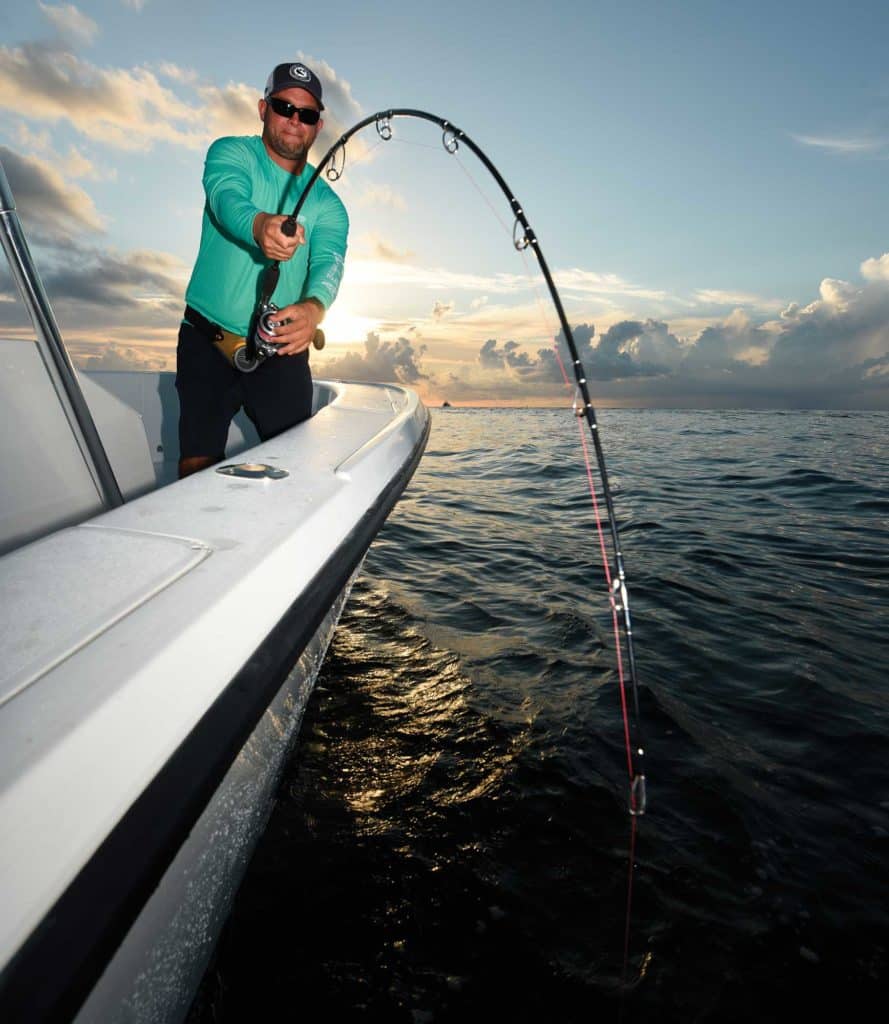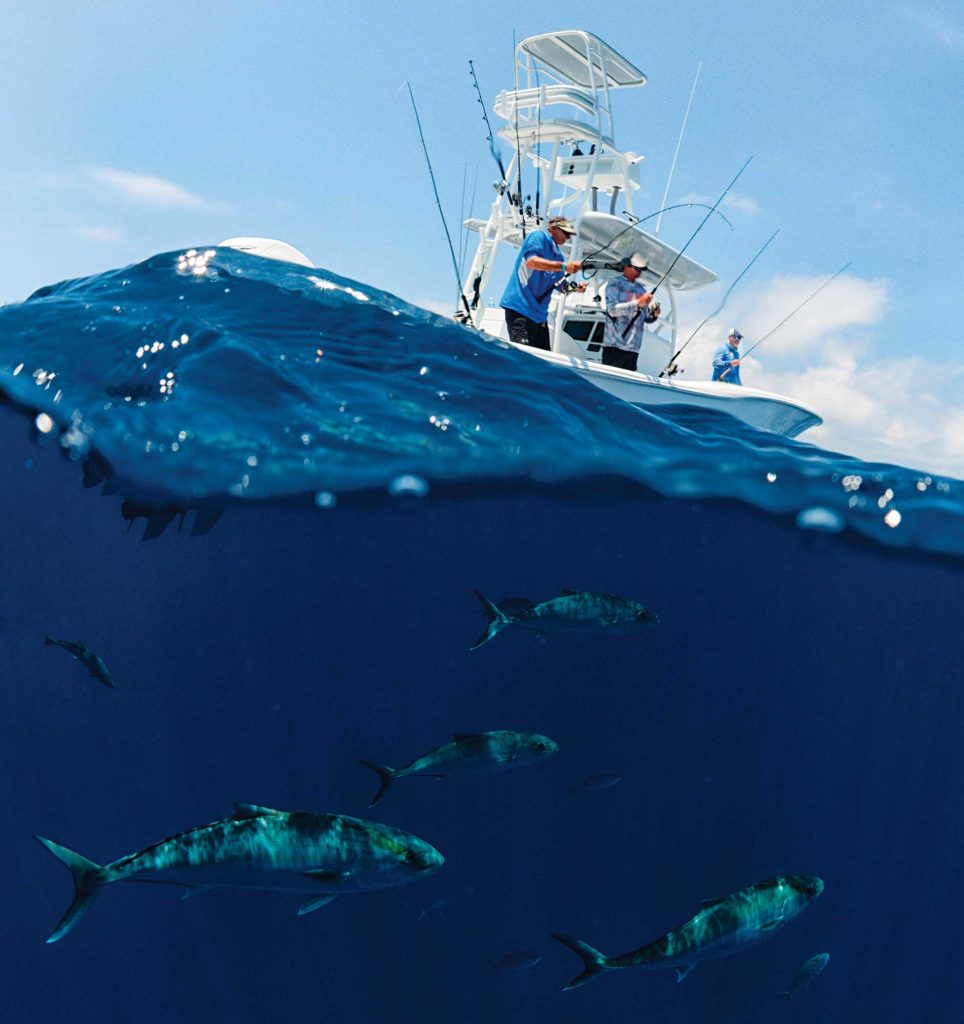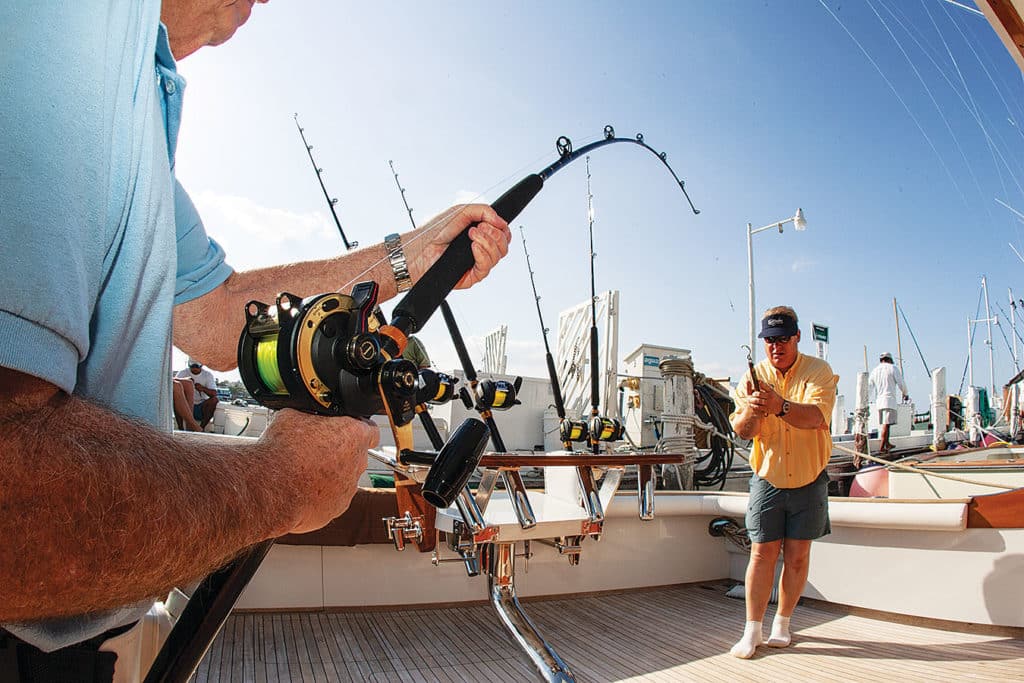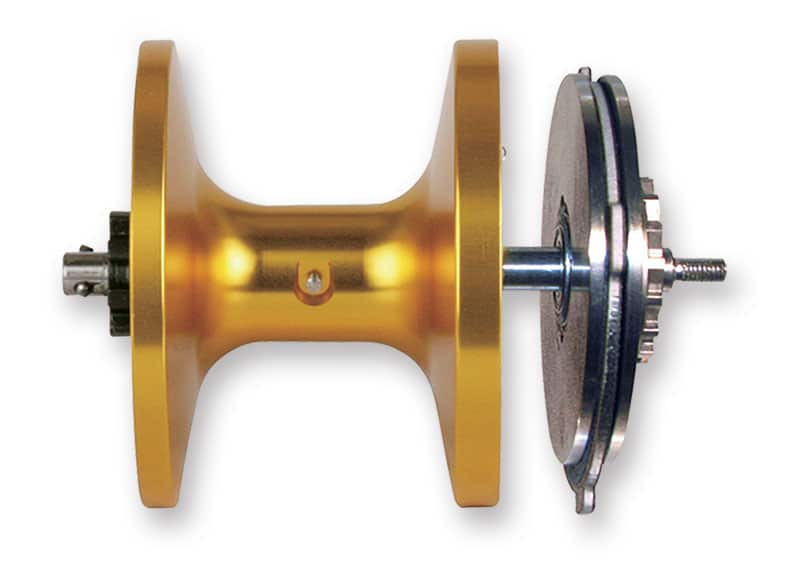
I was outgunned, pure and simple. Jigging for bluefin in the 40- to 80-pound range, I was using 30-pound-class gear with 65-pound braid and a 30-pound fluorocarbon wind-on leader when something significantly larger than expected inhaled my rather puny 4-inch pink Butterfly jig. It would take two and a half hours — and an immense expenditure of sweat — before we finally saw color.
The tuna settled into its death spiral for a final tug of war about 20 feet below the boat. But with the drag set at 10 pounds of pressure, forcing the fish any farther up in the water column was simply impossible. Should I apply a bit more drag, or thumb the spool? These questions shoot through the minds of countless anglers in the final moments of an epic battle.
We all know what forcing the issue usually leads to: a heart-breaking break-off. So instead of tightening the drag, I backed it off and we pulled the boat away from the fish, changing the angle of attack from vertical to nearly horizontal.
The bluefin came out of its spiral and allowed itself to be brought to the surface, albeit 50 yards away from the boat. I kept the pressure steady but never exceeded that of the preset drag, as the boat paralleled the fish, inching closer and closer. Too tired to turn and dive, the fish’s left eyeball was locked on my own when 10 minutes later, the gaff struck home.
The experience proved that having your drag properly set — and then using it properly — is quite literally a make‑or-break factor.

A Fine Line
“The old standard of setting the drag to between 25 percent and a third of the line’s rated strength still holds true,” says Shimano rep Capt. Bryan Williams of Wilmington, North Carolina, “but braid has changed things. In the old days, we’d move up the drag on big fish, but now I tell people to leave it alone.”
Williams notes that as a fish takes line, the drag pressure increases without any assistance from the angler because the spool’s diameter shrinks. Move the drag lever forward, and you stand an excellent chance of breaking off. He says the same goes for spinning reels, even though the change isn’t as noticeable. Adding pressure by thumbing the spool on any reel is an even worse move, he says, because you want the line moving as smoothly as possible.
“With today’s smaller, smoother reels, such as the Talicas I fish, touching the spool creates uneven pressure and increases the chance of pulling the hook,” he says.
Williams does point out, however, that you have to vary how you set the drag according to the type of fishing you’re doing. When targeting grouper, for example, he cranks up the drag to the point that only a very large fish can take drag, and then only a little. “You have to force those fish away from the ledges very quickly,” he explains, “or you’ll get chafed off before the line has a chance to break from the fish’s pull.”

Under Pressure
Capt. Will Burbach of Tampa, Florida, who spends much of his time forcing large snook out of mangroves and away from piers and bridges, uses drag pressure the same way. “Fishing in heavy cover, you can’t set your drag for small or average fish,” Burbach says. “You have to use heavier gear and really crank down on the drag. Yes, you will break off sometimes, but if you fish a light drag, you’ll get fouled or cut off almost all the time.”
When fishing in open water, such as targeting tarpon on the beach, Burbach says you can go lighter on the drag without as much break-off risk. Still, he says he sets drags at a third of the line’s breaking strength and often is willing to risk setting it even higher. “Part of it has to do with the fish,” he explains. “It has a better chance of recovery if you don’t stretch out the fight, and wear it down too much.”
Burbach also says that regardless of how you’re fishing, the worst thing an angler can do is fiddle with the drag on a spinning reel midfight. “Sometimes people loosen the drags I’ve set because it feels tight to them, and the next thing you know, they’re tangled in the mangroves,” he says. “Or maybe they overtighten an already tight drag, and break off. If you start messing with settings while a fish is on the line, you’ll never know where the drag is and where it really belongs.”

Setting the Mark
Interestingly, Williams and Burbach differ on how to set the drag in the first place. Williams always uses a scale, with the rod and reel at an appropriate fish-fighting angle. Burbach, on the other hand, says setting by feel works well, just as long as you know your gear inside and out. He tests the drag strength by pulling line by hand directly from the reel. He admits that this technique does require some trial and error, and says you’ve “gotta get the feel” through experience before you’ll be setting drags properly.
Capt. Kevin Beach, who runs Pale Horse out of Venice, Louisiana, uses both methods. “I set my drags by hand with the light stuff, and by scale with the heavy stuff,” he says. Beach also points out that it’s critical to set to your leader strength, not your line strength, when you’re forced to use lighter leaders to get bites from finicky fish.
Okuma’s product development director John Bretza stresses the importance of getting to know your gear. “I would take the time to familiarize myself with a new reel before use,” he says. “The drag systems in today’s reels can be your best advantage over big fish, but when used incorrectly, can have the opposite effect. Imagine driving a car and rather than gradually coming to a stop at a light, you slam on the brakes. If you don’t have a good feel for your drag and understand how the system works, and you overtighten the drag, you’ll have the same abrupt impact when a fish strikes your lure or bait.”
Like Williams, Bretza also notes that the rising popularity of braid has had a significant impact on how anglers set and use their drags. The elimination of significant stretch means that anglers using braid have a much less forgiving system. When the drag is set right, however, you have more firepower at your fingertips than anglers have ever had in the past, and being outgunned doesn’t mean you can’t catch that fish of a lifetime.
Read Next: New Fishing Reels for 2019
Drag Tech
By all accounts, the use of carbon fiber is one of the most important advancements in drag technology during the past decade. When compressed, it doesn’t have the same memory found in previously used drag materials. That memory could cause a major issue if an angler failed to loosen a reel’s drag for storage.
Carbon fiber also allows for the application of wet-drag systems, which include greases and can reduce start-up inertia and heat buildup. “We use Cal’s grease on Okuma lever drags,” says John Bretza, Okuma director of product development, “because it has proved to help reduce heat buildup.”
Shimano rep Bryan Williams says that Shimano’s Dartanium II woven carbon-fiber drag materials allow smaller reels to put out a lot more pressure than in the past. “Today I can hand a kid or a small woman a reel like a Trinidad 16, which anyone can handle, but it still puts out a lot of drag,” he says. “They fight the fish instead of fighting the gear.”








